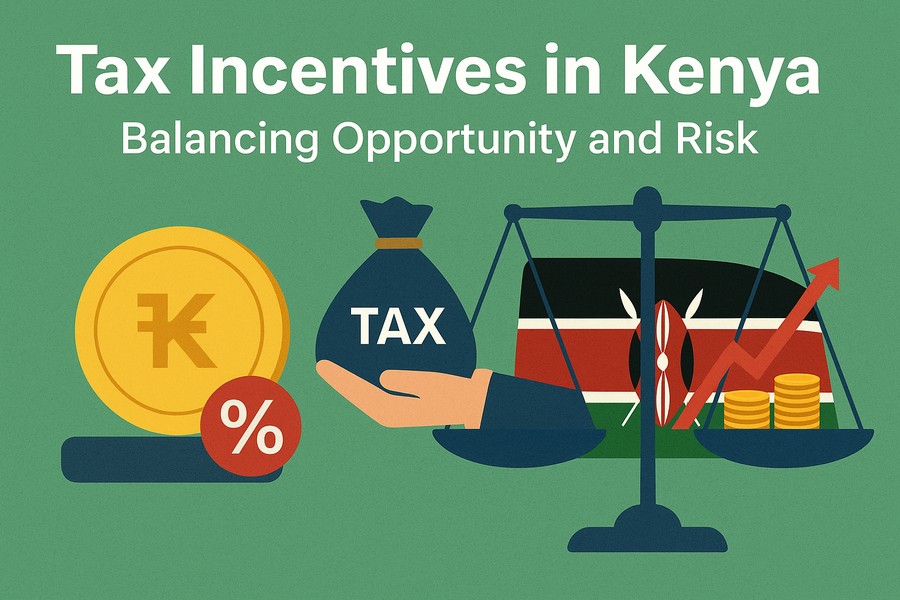
The Historical Roots of Tax Incentives
The use of tax incentives is not new—it dates back centuries. In the biblical story of David and Goliath, King Saul promised tax exemption and rewards to whoever defeated the Philistine giant. Similarly, in the Roman Empire, veterans received land grants and tax exemptions as rewards for loyalty and service.
These examples highlight the enduring role of tax incentives as tools to influence behavior and stimulate economic activity.
What Are Tax Incentives?
At their core, tax incentives in Kenya are government measures that reduce the tax burden on specific groups, industries, or activities. They serve several purposes:
- Promote investment in key sectors.
- Cushion consumers against high costs of essential goods.
- Encourage uptake of socially beneficial products or services.
- Promote equity and fairness in taxation.
Kenya categorizes incentives into:
- Direct tax incentives – covering corporate tax and individual income tax (e.g., deductions, investment allowances).
- Indirect tax incentives – applied to VAT, excise duty, and customs duties (e.g., exemptions, zero-rated VAT).
Types of Tax Incentives in Kenya
Kenya’s tax incentive framework is broad and includes:
- Tax holidays (e.g., Export Processing Zones).
- Special Economic Zones (SEZs) with preferential rates.
- Investment deductions and allowances.
- Accelerated depreciation.
- Preferential tax rates for targeted industries.
- Exemptions and zero-rated VAT on select goods and services.
- Financing incentives for real estate investment trusts (REITs) and collective investment schemes.
Export Processing Zones (EPZs)
Kenya has over 100 EPZs to drive export-led growth. Benefits include:
- 10-year corporation tax holiday, then 25% for the next decade.
- 10-year withholding tax holiday.
- 100% investment deduction on buildings and machinery.
- Waivers on import duty and VAT.
- Full foreign ownership allowance.
Special Economic Zones (SEZs)
Kenya operates at least 36 SEZs, attracting both local and international investors. SEZ incentives include:
- 10% corporation tax for the first 10 years, then 15% for the next 10 years.
- Exemption from withholding tax on dividends.
- 100% investment deduction on buildings and machinery.
- Exemptions from VAT, excise duty, and import duty.
- Zero-rated local supplies and a simplified “green tunnel” importation system.
- A minimum investment threshold of KSh 10 billion.
Preferential Tax Rates
- Some industries enjoy special tax rates to boost local production and housing development:
- 15% corporation tax rate for local motor vehicle assemblers (if 50%+ local content is achieved).
- 15% tax rate for developers of 100+ affordable housing units, subject to Cabinet Secretary approval.
Investment Allowances
Kenya offers generous investment deductions to stimulate industrial growth:
- 50% in year one and 25% annually thereafter for machinery, farm works, ships, aircraft, and hospital equipment.
- 100% deduction for SEZs and for investments above KSh 250 million outside Nairobi and Mombasa.
Personal Income Deductions
Kenyan taxpayers also benefit from personal reliefs, including:
- Pension contributions up to KSh 30,000 per month.
- Mortgage interest deduction up to KSh 30,000 per month.
- Affordable Housing Levy contributions (deductible).
- Medical fund contributions up to KSh 15,000 per month.
- Contributions to SHIF (Social Health Insurance Fund).
VAT Incentives
To support green energy, housing, and industrialization, Kenya exempts or zero-rates key products:
- Zero-rated: LPG gas, solar batteries, electric vehicles, locally assembled phones.
- Exempt: Briquettes, solar equipment, agricultural machinery, affordable housing construction materials.
The Downsides of Tax Incentives
Despite their advantages, tax incentives in Kenya come with challenges:
- Failure to deliver results – e.g., the Registered Home Ownership Savings Plan (RHOSP), introduced in 2006, was scrapped in 2023 due to low uptake.
- Tax system complexity – Multiple exemptions make compliance difficult for businesses and monitoring hard for KRA.
- Opportunities for avoidance – Loopholes are often exploited legally but unethically.
- Revenue loss – In 2023, KSh 510.56 billion in tax expenditure (over 20% of collections, 3.38% of GDP) was lost to incentives.
- Windfall gains – Some corporations enjoy huge breaks without boosting jobs or investment.
Conclusion
Tax incentives in Kenya remain a double-edged sword. They help attract investment, promote exports, and cushion key sectors like housing and renewable energy. However, they also create risks such as revenue loss, abuse, and policy complexity.
For Kenya to maximize benefits, incentives must be:
- Targeted at genuine growth sectors.
- Transparent to avoid abuse.
- Time-bound to encourage accountability.
- Continuously reviewed to measure impact.
If well-managed, tax incentives can fuel sustainable economic growth while safeguarding Kenya’s fiscal stability.
